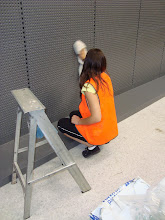There are a lot positive things you could say about using stainless steel in the home or office. Countertops, backsplashes, cabinetry and other installations are using stainless steel more for a fresh look, durability and for easy maintenance. If you are a commercial cleaning or office cleaning company, you will see, if you haven’t already, more and more commercial buildings are using stainless steel in elevators, splash backs and toilet fittings in bathrooms. However, many people forget that no surface is truly maintenance free. Stainless steel must still be regularly cleaned and if under the wrong, can even fall into bad disrepair.
Cleaning Stainless Steel:
To clean stainless steel involves little more than wiping the surface down with a mild soap or detergent followed by a rinse with just plain water. To finish off, just dry the surface for a better finish. Avoid using cleaning products wherever possible unless they are specifically approved for stainless steel surfaces. The only time you need to clean stainless steel is when it looks dirty.
Stainless Steel Maintenance:
Would you believe that one of the most dangerous materials to your stainless steel is other metals? Free iron deposits can be very harmful to your stainless steel surfaces. When this metal mixes with the surface of your stainless steel, a layer of low chromium can result in reduced corrosion resistance. If the situation goes unchecked, corrosion will occur, leading to costly repair. Pickling or passivation removes this low chromium layer with acid treatment leaving only a fully restored stainless steel surface in its wake. The main difference between the two processes is the exact mixture and application of the acid.
If you find that a simple soap and water cleaning doesn't work at all, you may need this evasive chemical treatment. With both processes, it involves the use of dangerous chemicals, so extreme caution should be properly exercised. Not only can they be harmful to you, the environment, but if not properly applied and completely extracted, your stainless steel as well. You may to consider hiring a professional to see if this treatment is necessary or warranted. However, to make sure your stainless steel has the longest life possible; it's a small price to pay.








No comments:
Post a Comment